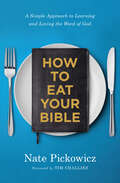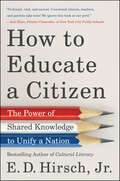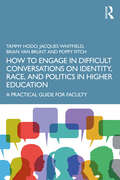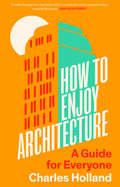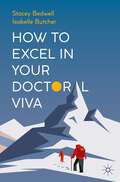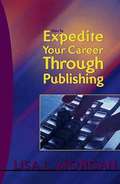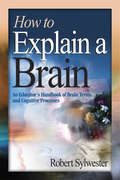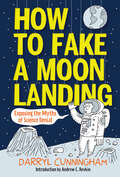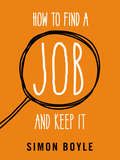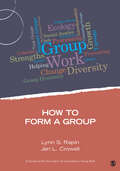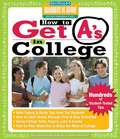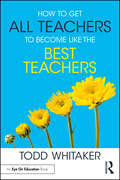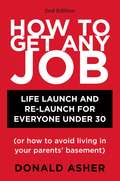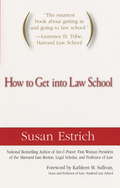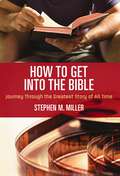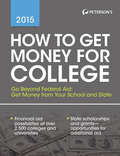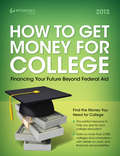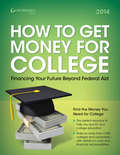- Table View
- List View
How to Eat Bread: 21 Nourishing Ways to Read the Bible
by Miranda Threlfall-Holmes'a fiercely intelligent theologian and historian' - The Independent'Miranda gives us the confidence to sit and taste the Bible's profound and life-changing goodness.' - Stephen Cottrell, Archbishop of YorkAs a vicar, Miranda Threlfall-Holmes is used to being asked to recommend a book on how and why to read the Bible. Filling the gap between popular Bible reading notes and more academic books, How to Eat Bread is the book she'd give to anyone wanting to explore the Bible as part of their faith. Its three main sections delve into the rich heritage of how Christians have read the Bible down the ages: From the Larder - ways that scripture itself uses other parts of scripture, or models and demonstrates different ways of reading Grandma's Recipe Book - historical methods of biblical interpretation Molecular Gastronomy - the insights and methods of modern theological hermeneuticsEncouraging readers to try out a variety of tried and tested ways of Bible reading, experiment with different ingredients and sample the results, How to Eat Bread is a refreshingly hands-on approach to understanding this ancient library of texts.'exhilarating and hands-on ... Miranda Threlfall-Holmes provides a fantastic guide' - Fergus Butler-Gallie
How to Eat Bread: 21 Nourishing Ways to Read the Bible
by Miranda Threlfall-Holmes'a fiercely intelligent theologian and historian' - The Independent'Miranda gives us the confidence to sit and taste the Bible's profound and life-changing goodness.' - Stephen Cottrell, Archbishop of YorkAs a vicar, Miranda Threlfall-Holmes is used to being asked to recommend a book on how and why to read the Bible. Filling the gap between popular Bible reading notes and more academic books, How to Eat Bread is the book she'd give to anyone wanting to explore the Bible as part of their faith. Its three main sections delve into the rich heritage of how Christians have read the Bible down the ages: From the Larder - ways that scripture itself uses other parts of scripture, or models and demonstrates different ways of reading Grandma's Recipe Book - historical methods of biblical interpretation Molecular Gastronomy - the insights and methods of modern theological hermeneuticsEncouraging readers to try out a variety of tried and tested ways of Bible reading, experiment with different ingredients and sample the results, How to Eat Bread is a refreshingly hands-on approach to understanding this ancient library of texts.'exhilarating and hands-on ... Miranda Threlfall-Holmes provides a fantastic guide' - Fergus Butler-Gallie
How to Eat Your Bible: A Simple Approach to Learning and Loving the Word of God
by Nate PickowiczLoving God means loving His Word.If you&’re feeling distant from God, could it be because you&’re ignoring His Word? But maybe you don&’t know where to start. Maybe the long books and strange names feel overwhelming. Maybe you just don&’t like reading. Whatever the case, How to Eat Your Bible will help you cultivate an appetite for life-long study of God&’s Word. Find practical guidance for overcoming the hurdles that have kept you from making Bible study a regular part of your life. You&’ll also become encouraged to pursue God&’s Word by learning how other Christians throughout time maintained this crucial practice. Pastor Nate Pickowicz also includes a unique Seven Year Bible Plan so that you can apply what you&’ve learned and continue drawing near to God as you consume His Word.
How to Eat Your Bible: A Simple Approach to Learning and Loving the Word of God
by Nate PickowiczLoving God means loving His Word.If you&’re feeling distant from God, could it be because you&’re ignoring His Word? But maybe you don&’t know where to start. Maybe the long books and strange names feel overwhelming. Maybe you just don&’t like reading. Whatever the case, How to Eat Your Bible will help you cultivate an appetite for life-long study of God&’s Word. Find practical guidance for overcoming the hurdles that have kept you from making Bible study a regular part of your life. You&’ll also become encouraged to pursue God&’s Word by learning how other Christians throughout time maintained this crucial practice. Pastor Nate Pickowicz also includes a unique Seven Year Bible Plan so that you can apply what you&’ve learned and continue drawing near to God as you consume His Word.
How to Educate a Citizen: The Power of Shared Knowledge to Unify a Nation
by E. D. Hirsch Jr.Why a dumbed-down curriculum is bad for our democracy: “A persuasive, scientifically sound case for an education revolution.” — Shelf AwarenessIn How to Educate a Citizen, E.D. Hirsch continues the conversation he began thirty years ago with his classic bestseller Cultural Literacy, urging America’s public schools, particularly at the elementary level, to educate our children more effectively to help heal and preserve the nation. Since the 1960s, our schools have been relying on “child-centered learning.” History, geography, science, civics, and other essential knowledge have been dumbed down by vacuous learning “techniques” and “values-based” curricula; indoctrinated by graduate schools of education, administrators and educators have believed they are teaching reading and critical thinking skills. Yet these cannot be taught in the absence of strong content, Hirsch argues.The consequence is a loss of shared knowledge that would enable us to work together, understand one another, and make coherent, informed decisions. A broken approach to school not only leaves our children underprepared and erodes the American dream but also loosens the bonds that hold the nation together. Drawing on early schoolmasters and educational reformers such as Noah Webster and Horace Mann, Hirsch charts the rise and fall of the American early education system and provides a blueprint for closing the national gap in knowledge, communications, and allegiance. Critical and compelling, How to Educate a Citizen galvanizes our schools to equip children with the power of shared knowledge.“Concerned citizens , teachers, and parents take note! We ignore this book at our peril.” —Joel Klein, former Chancellor of New York City Public Schools
How to Engage in Difficult Conversations on Identity, Race, and Politics in Higher Education: A Practical Guide for Faculty
by Brian Van Brunt Poppy Fitch Tammy L. Hodo Jacques WhitfieldHow to Engage in Difficult Conversations on Identity, Race, and Politics in Higher Education addresses the polarized political and racialized climate in the United States. This practical resource offers faculty and staff much needed direction related to hosting difficult conversations as they occur in the classroom, residence halls, orientation events, and coffee shops around college and university campuses. Chapters provide insights, case examples, interactive exercises, and "how-to" tools and tips to hosting these conversations, covering issues such as immigration, White supremacy in academia, women’s rights, the Black Lives Matter movement, trans rights, reproductive rights, and cancel culture, among many others. This resource is designed to better prepare instructors, faculty, higher education staff and administrators to enter into these hard conversations with an improved awareness of contentious issues and how to facilitate, and potentially de-escalate, discussions that are already occurring.
How to Enjoy Architecture: A Guide for Everyone
by Charles HollandCharles Holland challenges us to look beyond the day-to-day familiarity of buildings to rediscover the pleasure of experiencing architecture Architecture is bound up with our daily lives but, for most of us, it is experienced as a blur of habit. Our reactions towards the buildings that surround us are often culturally generated, and we experience them in ways that are immediate but often mundane. How to Enjoy Architecture: A Guide for Everyone encourages us to move beyond this and, instead, really look at buildings. Renowned architect Charles Holland talks about the buildings and architects that excite and inspire him, and the ideas and principles through which we can engage with architecture. By breaking buildings down into categories such as materials, structure, space, and use, Holland guides us through drastically different styles and building types—from the satisfying symmetry of a Queen Anne house to the thrill of a high-tech tower, or the social ideals that lie behind a housing estate. In doing so, he demonstrates how looking at, experiencing, and using architecture can bring joy in itself. "A book that will enrich any encounter with a building, it made me want to look harder and be more curious. We are led playfully through the fundamentals of architecture so that we might enjoy the details and the poetry of buildings all the more. A walk through the city feels more fun and also more profound after reading this book." Grayson Perry, artist "We so often encounter architecture when it goes wrong, or offends us with its looks. Holland, though, is the perfect, clear-headed tour guide to help us appreciate it with newly sharpened senses and fall in love again – even those buildings we think we hate." Tom Dyckhoff, academic and broadcaster "An enlightening and urbane exploration of architecture that resonates beyond conventional chronological histories" Catherine Slessor, architecture writer and critic
How to Enjoy Art: A Guide for Everyone
by Ben StreetAn entertaining and lively guide to rediscovering the pleasure in artHow to Enjoy Art: A Guide for Everyone provides the tools to understand and enjoy works of art. Debunking the pervasive idea that specialist knowledge is required to understand and appreciate art, instead How to Enjoy Art focuses on experience and pleasure, demonstrating how anyone can find value and enjoyment in art. Examples from around the world and throughout art history—from works by Fra Angelico and Berthe Morisot to Kazuo Shiraga and Kara Walker—are used to demonstrate how a handful of core strategies and skills can help enhance the experience of viewing art works. With these skills, anyone can encounter any work of art—regardless of media, artist or period—and find some resonance with their own experiences. How to Enjoy Art encourages us to rediscover the fundamental pleasure in viewing art.
How to Escape Lifetime Security and Pursue Your Impossible Dream: A Guide to Transforming Your Career
by Kenneth AtchityFor the Type C, or creative, personalities who want their work to "fill" their deepest creative urges, this is the frontline guide to making the transition from a secure and soulless job to a life built around a creative dream. Individuals learn how to follow the mind's eye to construct a life that conforms to personal vision, steal time to make creative dreams come true, use as assets the resources around them, and turn creative goals and objectives into an effective life plan. Introduces the catchy buzzword "Type C"Allworth Press, an imprint of Skyhorse Publishing, publishes a broad range of books on the visual and performing arts, with emphasis on the business of art. Our titles cover subjects such as graphic design, theater, branding, fine art, photography, interior design, writing, acting, film, how to start careers, business and legal forms, business practices, and more. While we don't aspire to publish a New York Times bestseller or a national bestseller, we are deeply committed to quality books that help creative professionals succeed and thrive. We often publish in areas overlooked by other publishers and welcome the author whose expertise can help our audience of readers.
How to Excavate a Heart
by Jake Maia ArlowStonewall Honor author Jake Maia Arlow delivers a sapphic Jewish twist on the classic Christmas rom-com in a read perfect for fans of Kelly Quindlen and Casey McQuiston.It all starts when Shani runs into May. Like, literally. With her mom’s Subaru.Attempted vehicular manslaughter was not part of Shani’s plan. She was supposed to be focusing on her monthlong paleoichthyology internship. She was going to spend all her time thinking about dead fish and not at all about how she was unceremoniously dumped days before winter break.It could be going better.But when a dog-walking gig puts her back in May’s path, the fossils she’s meant to be diligently studying are pushed to the side—along with the breakup.Then they’re snowed in together on Christmas Eve. As things start to feel more serious, though, Shani’s hurt over her ex-girlfriend’s rejection comes rushing back. Is she ready to try a committed relationship again, or is she okay with this just being a passing winter fling?
How to Excel in Your Doctoral Viva
by Stacey Bedwell Isabelle ButcherHow to excel in your doctoral viva offers an accessible guide to approaching and preparing for a PhD viva examination. The book explains what the viva is, how the process works, and what the purpose of the viva is. It guides the reader through the course of preparing for their viva examination, with chapters focusing on organisation to dealing with viva concerns. Contributions from over 25 academics ranging from critical care to theology provide a unique insight into the experiences of PhD candidates and examiners, and make this book an invaluable resource for students completing PhDs across the sciences.
How to Expedite Your Career Through Publishing
by Lisa L. MorganThere are a lot of books dedicated to career building and a lot of books dedicated to writing. Some will teach you how to write better resumes, business letters, or business plans. Yet, none really focus on how to build a career through publishing. That's what this book is all about. Clear examples; lots of resources.
How to Explain a Brain: An Educator's Handbook of Brain Terms and Cognitive Processes
by Robert A. SylwesterDiscover how the brain is organized and develops and how educators can use this emerging understanding of cognition to enhance student learning and the school environment.
How to Fake a Moon Landing: Exposing the Myths of Science Denial
by Darryl CunninghamA collection of &“lively, plain-language debunkings of seven cases of quack or fraudulent science and . . . antiscientific bias in general&” (Booklist). Is hydro-fracking safe? Is climate change real? Did the moon landing actually happen? How about evolution: fact or fiction? Author-illustrator Darryl Cunningham looks at these and other hot-button science topics and presents a fact-based, visual assessment of current thinking and research on eight different issues everybody&’s arguing about. His lively storytelling approach incorporates comics, photographs, and diagrams to create substantive but easily accessible reportage. Cunningham&’s distinctive illustrative style shows how information is manipulated by all sides; his easy-to-follow narratives allow readers to draw their own fact-based conclusions. A graphic milestone of investigative journalism! &“Cartoonist Darryl Cunningham . . . is a welcome voice, shedding some much needed light on the darker areas of science and culture. . . . Cunningham does a remarkable job with difficult material and for high school students, just opening their eyes to the world around them, this is a terrific primer.&” —ComicMix
How to Find a Job and Keep It
by Simon BoyleLooking for a job? Don’t know where to start? This friendly book is here to help you. Learn how to:· Write a CV and covering letter· Contact employers and recruitment agencies· Manage your personal finances· Act professionally in a work environment And most important of all:· Find a job you love, and keep it! So why not open it now and get going?
How to Form a Group (Group Work Practice Kit)
by Lynn S. Rapin Jeri L. CrowellForm groups that empower growth, learning, and change Drawing on the latest research on group work, this accessible book will help you master key concepts and skills. Providing insightful coverage of diversity and multicultural issues, How to Form a Group focuses on all aspects of forming an effective group, including: Strategies for overcoming environmental roadblocks to group formation, such as agency staff lack of support for groups Key practices to consider when organizing groups Practical guidance on how to attract the "right" members to the "right" groups Concrete suggestions for organizing, marketing, recruiting, screening, selecting, and composing groups Differentiation between groups that are remedial in purpose from those that are more preventive in scope How to Form a Group is part of the Group Work Practice Kit: Improving the Everyday Practice of Group Work, a collection of nine books each authored by scholars in the specific field of group work. To promote a consistent reading experience, the books in the collection conform to editor Robert K. Conyne’s outline. Designed to provide practitioners, instructors, students, and trainees with concrete direction for improving group work, the series provides thorough coverage of the entire span of group work practice. This book is endorsed by the Association for Specialists in Group Work.
How to Get A's in College
by Hundreds of Heads BooksThese days college is not a luxury but a necessity. With four (or more) long years of college life ahead of them, it's essential that students have some help to make the most of their time. This book explains how, featuring peers who talk directly and personally to students. Here, hundreds of successful college grads explain how to get top grades, find the right major, manage time, stay motivated, avoid stress, seek out the best teachers and courses, form important relationships, and graduate - happily - at the top of the class. Short, pithy chapters cover such topics as writing a good paper, research and the college library, taking advantage of college support services, balancing athletics and academics, navigating modern college technology, and more.
How to Get All Teachers to Become Like the Best Teachers
by Todd WhitakerThere are dramatic differences in the quality of teachers in every school. Every building has teachers who consistently engage students and deliver high-quality instruction. Every building also has teachers with varying ranges of ability. If all teachers could be more like the best teachers, then we would have significant improvement in every school.In this important book, Todd Whitaker demonstrates how this can really be achieved. With inspiration, humor, and practical advice, Whitaker shares the qualities of the best teachers and how we can teach these qualities to others. He shows how the best teachers emphasize the learning relationship; focus only on what they can influence; and use effective classroom management involving filtering, proximity, redirection, and business mode. He then explains how we can coach other teachers by showing, not telling; by creating subcultures and learning experiences; and by leading the way. Finally, Whitaker describes the importance of hiring highly talented people who form new lines rather than fall in line. He provides strategies for asking the right interview questions, for choosing the right mentors, and for selecting the best hosts for student teachers.No matter how education changes, there are always outstanding teachers making a difference. We can grow our schools by helping even more teachers become exceptional.
How to Get Any Job, Second Edition: Career Launch and Re-Launch for Everyone Under 30 (or How to Avoid Living in Your Parents' Basement)
by Donald AsherPhilosophy majors and GPA-challenged students, rejoice! According to career guru Donald Asher, what you major in or how well you do in college are not indicators of future career success. In HOW TO GET ANY JOB WITH ANY MAJOR, Asher debunks the myth that only brainy students with specialized majors find high-paying, visible careers after college. The truth is that plenty of average folks with general, liberal arts majors have gone on to find lucrative and fulfilling careers-and anyone can do it by following Asher'¬?s advice. If you'¬?re just graduating, you'¬?ll learn to promote the skills you already have, recognize how employers hire and what skills they value most, and get influential people to help you. Or, if you'¬?re already in the work world, you'¬?ll learn to use internships, credential programs, post-baccalaureates, and grad school to jump-start a stalled career. Offering innovative ideas to help launch the perfect career, HOW TO GET ANY JOB WITH ANY MAJOR is the new job-hunter'¬?s handbook to success.From the Trade Paperback edition.
How to Get Into Law School
by Susan EstrichWhether you’re is a college junior facing the LSATs, a senior sitting with disappointing test scores, or someone who has always dreamed of a career in the law, there is too much at stake not to ask the hard questions about what lies ahead. How to Get into Law School will tell you all you need to know about: Choosing and applying to law school The law school admission test (LSAT) and law school applications Getting into law school Suceeding as a student Finding career fulfillment In How to Get Into Law School, Susan Estrich lends her unique point of view and far-ranging experience-as ace law student, tenured professor, renowned legal scholar and analyst-to the life and career questions applicants will face, and answers them in the frank, no-nonsense manner that is her trademark. Featuring anecdotes from admissions directors, professors, veteran attorneys, and adventurous students alike, How to Get Into Law School lays out the facts on: Applications Essays Getting Scholarships Community service The Rigors of Studying Surviving Interviews Finding Employment If you’re considering going to law school, this is your indispensable how-to guide. .
How to Get Into the Bible
by Stephen M. MillerJourney through the greatest story of all time. How to Get Into the Bible is a fast-paced, action-packed look at the main characters, events, and meanings of the Old and New Testament. This is the perfect handbook of the Bible for people who love movies, comic books, television, and the Internet. Written with Bible texts from the reader-friendly Contemporary English Version, this book makes it even easier for adults who are unfamiliar with the Bible to get into the Scripture. Features include: Outlines Illustrations Coverage of the entire Bible story Fresh look for easy reading
How to Get Money for College 2013
by Peterson'sHow to Get Money for College: Financing Your Future Beyond Federal Aid 2013 is a great resource for anyone looking to supplement his or her federal financial aid package with aid from colleges and universities. This comprehensive directory points the reader to complete and accurate information on need-based and non-need gift aid, loans, work-study, athletic awards, and more. This eBook offers profiles of more than 2,400 schools' financial aid awards, including types of aid, percentages of students applying for and receiving aid, and average aid packages; comprehensive overview of the financial aid process, common financial aid questions, samples of financial aid award letters, and how to file the FAFSA and CSS/Financial Aid PROFILE®.
How to Get Money for College 2013
by Peterson'sHow to Get Money for College: Financing Your Future Beyond Federal Aid 2013 is a great resource for anyone looking to supplement his or her federal financial aid package with aid from colleges and universities. This comprehensive directory points the reader to complete and accurate information on need-based and non-need gift aid, loans, work-study, athletic awards, and more. This eBook offers profiles of more than 2,400 schools' financial aid awards, including types of aid, percentages of students applying for and receiving aid, and average aid packages; comprehensive overview of the financial aid process, common financial aid questions, samples of financial aid award letters, and how to file the FAFSA and CSS/Financial Aid PROFILE®.
How to Get Money for College 2013: Financing Your Future Beyond Federal Aid
by Peterson'SHow to Get Money for College: Financing Your Future Beyond Federal Aid 2013 is a great resource for anyone looking to supplement his or her federal financial aid package with aid from colleges and universities. <P><P>This comprehensive directory points the reader to complete and accurate information on need-based and non-need gift aid, loans, work-study, athletic awards, and more. <P>This eBook offers profiles of more than 2,400 schools' financial aid awards, including types of aid, percentages of students applying for and receiving aid, and average aid packages; comprehensive overview of the financial aid process, common financial aid questions, samples of financial aid award letters, and how to file the FAFSA and CSS/Financial Aid PROFILE®.
How to Get Money for College 2014: Financing Your Future Beyond Federal Aid
by Peterson'SHow to Get Money for College: Financing Your Future Beyond Federal Aid 2014 is a great resource for anyone looking to supplement his or her federal financial aid package with aid from colleges and universities. <P><P>This comprehensive directory points the reader to complete and accurate information on need-based and non-need gift aid, loans, work-study, athletic awards, and more. <P>This eBook offers profiles of more than 2,400 schools' financial aid awards, including types of aid, percentages of students applying for and receiving aid, and average aid packages; comprehensive overview of the financial aid process, common financial aid questions, samples of financial aid award letters, and how to file the FAFSA and CSS/Financial Aid PROFILE®.

